|
January 20, 2022
Dear Neighbors and Friends,
I hope that you and your loved ones are doing well, staying healthy, and looking out for your neighbors and friends during this past week.
The number of new COVID cases remains VERY high here in Oregon, though as you'll see in the various graphs in tonight's newsletter, we're starting to see a leveling off of new cases.
However, as you'll see in the County report, numbers are continuing to increase at a very high rate in our more rural areas. (As we’ve seen elsewhere in the country, Omicron hits more congested urban areas first, then spreads.) This could lead to problems for us in the upcoming weeks since our rural areas tend to have lower vaccination rates, and the unvaccinated are at much greater risk of hospitalization and death from COVID, even from the Omicron variant. Highly-stressed rural hospitals can expect to be even more stressed.
For the state as a whole, we’re (fortunately) continuing to see relatively low death rates right now. I mentioned last week that our most recently-reported death numbers were deceptively high, the result of late reporting of COVID deaths that had occurred many months ago and never made it to OHA from the CDC or medical examiners. I did reach out to OHA about that problem. They agreed that it was a problem and steered me to a dashboard that shows week-over-week numbers of deaths by actual date of death, not when they were reported (i.e., they go back and plug those late-reports into the weeks they actually occurred. You can find that dashboard here. It’s updated once a week.
Omicron appears to have peaked in those states that were first hit by it. We’re seeing cases and hospitalizations in decline in those states. We’re a couple of weeks behind. (We may already be seeing case numbers peaking in Multnomah County.) As you’ll see in today’s OHSU forecast, we should see Oregon’s surge in new COVID infections peak next week, and the number of new hospitalizations reach their peak the week after. The forecast’s hospital peak has been adjusted downward a little to reflect the impact that behavior changes (more mask-wearing, less group indoor activities) have had on spread here in our state. Thank you all for what you’ve been doing to keep yourself and others safe.
A piece of positive news was the announcement by the Biden administration that every household that submits a request will receive four free COVID tests in the mail. See more on that below. As you know, testing has become very difficult to access. As a result, in many cases it’s only those who are clearly symptomatic who are getting tested, and our test positivity rate is at an astounding 27% today. (Anything over 10% is an indication that not enough testing is occurring.) The newly available home tests may not help our positivity rate much—since those who test at home rarely report their outcomes to the County—but they will certainly help many individuals with their decision-making.
I put in our request a few days ago. Presumably it will take a week.
While I’m patiently awaiting my delivery, I can tell you that I’m staying very, very busy on the legislative front. We (Representative Barbara Smith Warner, Rep Khanh Pham, and I) had a great town hall this evening, sharing information about the upcoming short legislative session that begins on February 1 and ends no later than the first week of March. The scramble is definitely on to get bills in final shape for the session. Unlike during the long session, we really don’t have time for much in the way of amendments once the session begins—so there’s enormous pressure to get problems worked out now, in advance of Tuesday, February 1.
We still don’t know all the bills that are out there, but we will pretty soon. Next Tuesday (or Wednesday at the latest) we’ll see bills and committee agendas posted on OLIS.oregonlegislature.gov. Once they are, you can sign up to be notified of any action that is occurring on any of the measures you’re tracking. You can also sign up to follow all the work being done by committees you’re interested in. (If you have any questions about how to do this, please send an email.)
I’ll have more info for you about the upcoming session in the next newsletter.
Let me close by saying how excited I am to be welcoming two new senators to our caucus, each of them selected by county commissions to fill out the remainder of their predecessors’ terms: Senator-appointee Rachel Armitage from Columbia County (who is filling out the year in place of Senator Betsy Johnson, who resigned her Senate seat to spend more time campaigning for Governor) and Senator-appointee Janeen Sollman from Washington County (who resigned her current position as a Representative to replace Senator Chuck Riley, who has retired early). Sadly, we’ve been asked to stay away from the Capitol for now as a result of Omicron, so I won’t be able to be there in person for the swearing-in, but it will be available for streaming through the legislative website, and I look forward to that.
Until the next newsletter, please stay healthy and safe, and let me know if you have any questions about information in tonight’s newsletter.
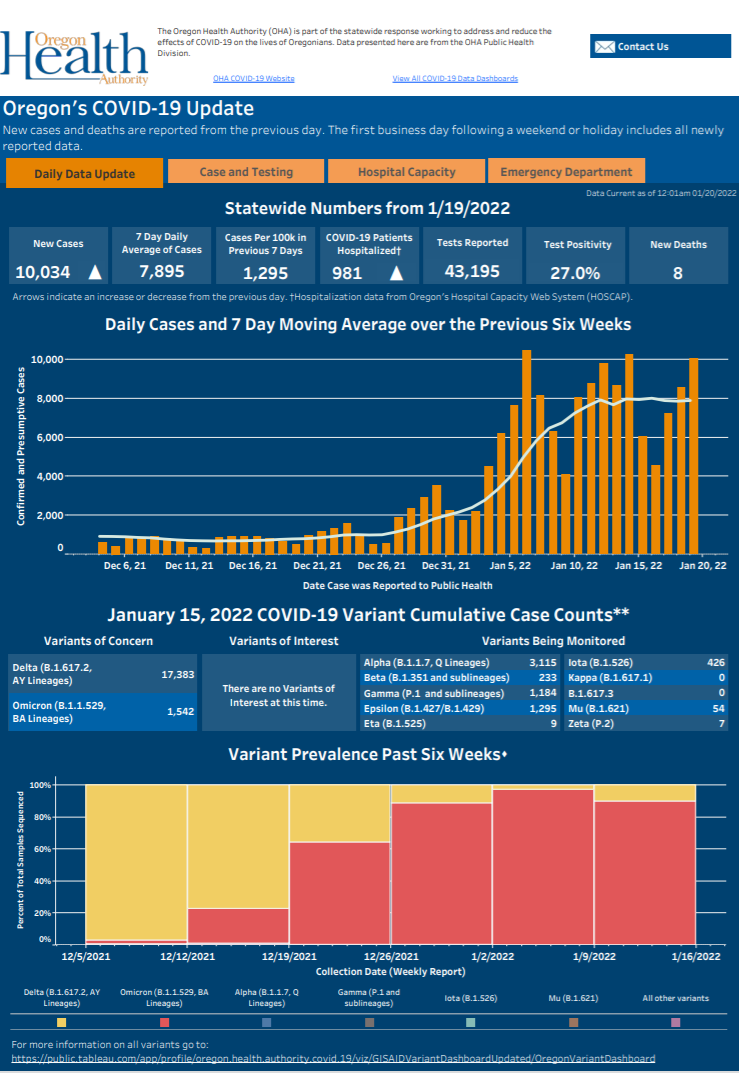
OREGON CORONAVIRUS AND CORONAVIRUS RESPONSE UPDATE
-
New COVID Cases: OHA reports 10,034 new COVID cases today, vs. 9,796 last Thursday. That’s an average of 7,890 per day for the last week (vs. 7,923 per day the previous week). The cumulative number of cases in Oregon since the beginning of the pandemic is 559,960.
-
Variant COVID Cases:
- OHA is now showing us not only this week’s variant cases but the growth of the different variants in Oregon over time. You can see in the graph above that Omicron is now responsible for nearly all the cases in this state (though interestingly this week we see a higher share of Delta than we saw last week). This graph is updated every Wednesday.
- OHA’s Variant Dashboard provides current and new variant case numbers for the state as a whole but also for different parts of the state. It too is updated each Wednesday.
-
Positive Test Results: OHA reported 11,663 positive test results today (vs. 11,548 last Thursday). That’s an average of 10,125 per day for the 7 days since the last newsletter (vs. 9,889 per day the previous week). The cumulative total of positive test results since the beginning of the pandemic is now 748,029.
-
Total Tests: OHA reported an additional 43,195 tests today (vs. 50,872 last Thursday). That’s an average of 43,327 per day for the last week (vs. 44,744 for the previous week). Our cumulative total of reported tests is 9,458,339
-
Positivity Rate: The test positivity ratio for Oregon today was an incredible 27.0% (even higher than the incredible 22.7% last Thursday)). That’s an average of 23.4% per day for the last week (vs. 19.4% last week).
-
Hospitalization Information:
- Patients Currently with Confirmed COVID-19: 981 (204 more than last newsletter)
- ICU Patients Confirmed w COVID-19: 142 (6 fewer than last newsletter.)
- Confirmed COVID-19 Patients Currently on Ventilators: 67 (8 more than last newsletter)
- Available Ventilators: 855 (2 fewer than last newsletter).
-
Hospital Capacity:
- Available Adult ICU Beds: 45 (7% availability) (9 more than last newsletter).
- Other Available Adult Beds: 251 (6% availability) (18 more than last newsletter).
- Available Pediatric ICU Beds: 6 (15% availability) (same as last Thursday).
- Here’s a link to more OHA data on hospital capacity.
-
Deaths: I’m sorry to report 8 additional COVID deaths today (vs. 25 last Thursday). That’s an average of nearly 7 per day for the week since the last newsletter (vs. 20 the previous week, an inflated number due to late reporting of deaths that occurred a while ago). The total number of COVID deaths in Oregon is 5,916.
-
Vaccinations:
- OHA reported today that 18,244 new doses of COVID-19 vaccinations were added to the state immunization registry on Jan. 19. Of that total, 1,398 were initial doses, 941 were second doses and 5,509 were third doses and booster doses. The remaining 7,950 were administered on previous days but were entered into the vaccine registry Jan. 19.
- The seven-day running average is now 14,865 doses per day (down from 16,057 a week ago).
- Total doses administered: 7,063,785
- 3,974,479 Pfizer/Comimaty vaccines
- 197,799 Pfizer Pediatric vaccines
- 2,616,235 Moderna vaccines
- 262,498 Johnson & Johnson vaccines
- Progress towards Governor’s goal of 2 million boosters by the end of January (announced Dec. 17): 77,542
- When the challenge began, 949,749 people had received a booster dose.
- Since then, 338,154 Oregonians have received a booster (up by 77,542 from last week).
- As of today, Oregon needs 584,304 people to get a booster to reach the goal.
- Total Oregonians vaccinated so far: 3,103,690 (up by 18,979 from last week)
- 2,809,173 now fully vaccinated with two doses (up by 29,449 from the previous week)
- So far, 75.5% of all Oregonians have received at least one dose
- 79.8% of those 5 and older
- 84.1% of those 12 and older
- 85.6% of those 18 and older
- 95% of those 65 and older
- 67.4% of all Oregonians are now fully vaccinated
- 71.3% of those 5 and older
- 75.7% of those 12 and older
- 77.0% of those 18 and older
- 85.66% of those 65 and older
- 45.5% of all Oregonians have received a booster shot
- 49% of those 18 and older
- 61.3% of those 50 and older
- 70.6% of those 65 and older
- All these percentages are from the CDC Data Tracker.They include vaccinations administered by the VA and Tribal Health Services.
- For more details, including the demographics of those receiving the vaccine and the number of vaccinations by county, go to the OHA vaccinations dashboard.
-
Bloomberg Newsprovides a wealth of easy-to-read information on the trajectory of vaccinations—by state, nationally, and internationally.
Quick Updates and Links
- As you’ll see elsewhere in the newsletter, we’re starting to see a leveling off of the big increases in new hospitalizations, especially in ICUs. That’s great news, but Oregon's emergency departments are still very stressed.Here's the latest from the Oregonian.
- In today’s Checkup with Dr. Wen, Wen looks at the prognosis for those who are immunocompromised. In the short run, she believes they need to remain extremely careful. But in a few months things should be better, thanks to increased access to testing and various medical treatments.
- Sticking with the subject of the immunocompromised, here are the latest disappointing study results regarding the efficacy of further boosters. Certain autoimmune-disease treatments appear to be the problem.
- While we have increasing evidence that Omicron is less virulent than Delta for the vaccinated, it would be a mistake to call it "mild."
- There’s further evidence that a combination of vaccination and infection created the most protection from Delta.
- As many schools struggle with their response to COVID, Portland Public Schools nurses have issued a strong criticism of the District's decisions. And the district responds.
- Many parents of young children will be relieved to hear Dr. Fauci’s prediction that the CDC will be approving vaccines for the very youngest, as soon as the end of February.
- Two populations most likely to become hospitalized by COVID: the homeless and the incarcerated.
- And here’s a new pre-publication study showing the social determinants of death from COVID.
- Axios looks at the likelihood that the end of the Omicron wave is in sight.l
- Nevertheless, the Surgeon-General cautions against complacency. For most of the country, the next few weeks are going to be tough.
- I would say that one of the most insightful writers about the pandemic has been sociologist and NY Times opinion writer Zeynep Tufekci. She has just recorded a long interview with Ezra Klein. You can find the interview and the transcript interview and the transcript here. Highly recommended.
- Here’s interesting new research into the genetic link that connects to the loss of smell in COVID patients.
- We’re hearing broad agreement that cloth masks alone are not adequate to keep those with COVID from spreading the virus. So what should you be using? It’s confusing, as the market is full of options--and counterfeits.
- Brain injury markers appear to be elevated in hospitalized COVID patients. Here’s more. Here's more.
- Over the last few weeks we’ve begun to see the experts pay less attention to reported COVID case counts. Here's why.
- Among the challenges the CDC has been facing: having to make quick decisions with inadequate data
- More on the boosting question.
- A children’s hospital weighs in on that polarizing question: should schools remain in-person or go to remote learning.
- And here, Elizabeth Miller from OPB answers a variety of questions related to COVID and schools.
- Vaccines don’t “prevent” COVID, and it’s dangerously misleading to say they do. But their benefits remain enormous.
- JAMA did a one-year lookback at our experience with vaccines: "A Shot of Hope, a Dose of Reality."
Federal Government Taking Orders for Free COVID Tests
On Tuesday the federal government launched a new website where you can order free at-home rapid antigen tests, to be delivered to your home by the U.S. Postal Service. Current supply limits orders to four tests per residential address. It will take at least a week after an order is placed for tests to be shipped (for free) first-class mail. Click here for more information on the federal government’s plans to make COVID-19 testing accessible to everyone.
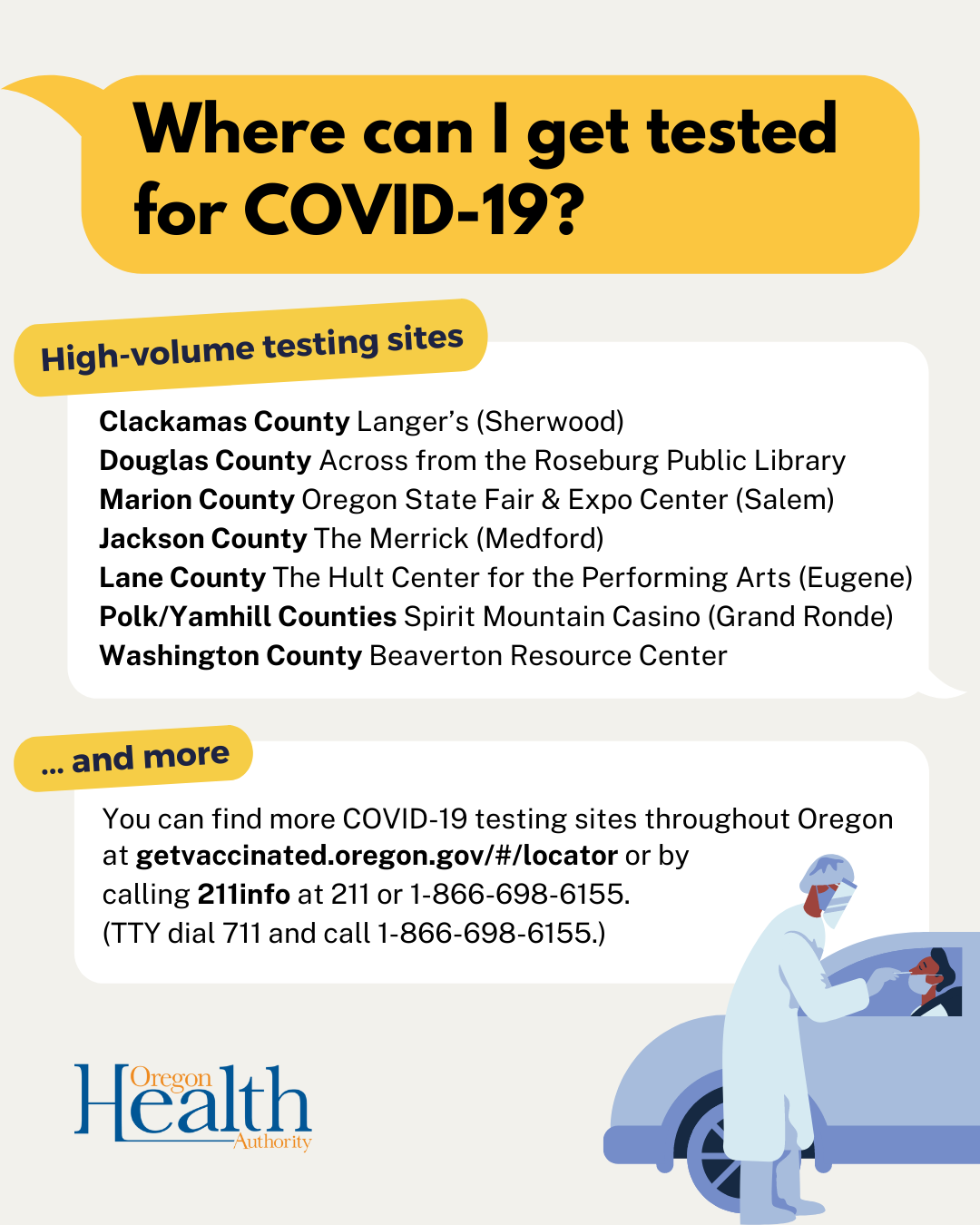
Weekly County Report: The Numbers Are Again Incredible
The latest OHA county report, showing weekly increases/decreases in COVID spread for each county and for the state as a whole, was released on Tuesday (normally Monday, but this week Monday was a holiday). It shows case counts and rates for the last four weeks, including the week that ended Sunday, January 16.
The Omicron transmission numbers reported this week continue to be astounding. If there’s any consolation, it’s that the doubling and tripling of previous weeks appears to be beginning to level off in many areas and for the state as a whole.
The state as a whole remains at EXTREME HIGH RISK of infection. The infection rate has continued to increase, from an already astounding 1,063.4 per 100K last week to 1,303.1 this week; the test positivity rate has also continued to rise, from 21.6%. to 22.0%.
As we’ve seen around the country, the big early jumps were in our more populous counties, and they remain extremely high; however, while their numbers are high, their increases are not. The big percentage increases have now spread to the less populous rural counties now Let’s hope that they too will start to level off..
OHA Weekly Report Continues to Show Big Statewide Increase in Cases and Positivity Rates, but Reductions in Hospitalizations and Deaths
OHA’s COVID-19 Weekly Report released today shows an increase in daily cases and a drop in hospitalizations and deaths.
- OHA reported 52,337 new cases of COVID-19 during the week of Monday, Jan. 10, through Sunday, Jan. 16. That is an 11% increase from the previous week and another weekly high for the pandemic. (But the rate of increase isn’t as high as it has been.)
- There were 320,710 tests for COVID-19 for the week of Jan. 9 through Jan. 15, a 24% increase over the previous week and a new weekly high.
- The percentage of positive tests rose to 22%, up from 21% last week.
- There were 441 new COVID-19 hospitalizations, down from 486 last week.
- There were 83 reported COVID-19 related deaths, down from the 113 reported the previous week.
Today’s COVID-19 Weekly Outbreak Report shows 210 active COVID-19 outbreaks in senior living communities and congregate living settings, an increase from last week’s 128.
1/13/21 202 facilities
2/10/21 116 facilities
3/10/21 44 facilities
4/14/21 24 facilities
5/12/21 42 facilities
6/09/21 19 facilities
7/8/21 22 facilities
8/4/21 33 facilities
9/1/21 144 facilities
10/6/21 163 facilities
11/3/21 87 facilities
12/1/21 54 facilities
1/05/22 64 facilities
1/12/22 128 facilities
1/20/22 210 facilities
The total number of deaths for people in congregate care can be seen below. As you’ can see, as the number of cases is increasing, the number of new deaths among congregate care residents has gone down. (Largely because of last week’s inflated number of reported deaths, due to late reporting from long ago.)
8/4 1,374 (pandemic total)
8/11 1,385 (pandemic total) +11
9/1 1,441 (pandemic total) +22
10/6 1,574 (pandemic total) +27
11/03 1,701 (pandemic total) +29
11/24 1,826 (pandemic total) +36
12/1 1,847 (pandemic total) +21
12/8 1,863 (pandemic total) +16
12/15 1,890 (pandemic total) +27
12/22 1,912 (pandemic total) +22
12/29 1,922 (pandemic total) +10
01/05 1,923 (pandemic total) + 1
01/12 1,946 (pandemic total) +23
01/20 1,961 (pandemic total) +15
The Outbreak Report also includes the latest data on COVID in workplaces, childcare centers, and public and private K-12 schools.
Unvaccinated Oregonians Make Up More and More of Our New COVID Cases
OHA’s most recent update on COVID-19 breakthrough cases, released today, reported 55,612 cases of COVID-19 during the week of Jan. 9 to Jan.15. It shows another jump in the number of new cases that are among the unvaccinated.
Of those cases, 45,042, or 81%, were unvaccinated people (vs. last week’s 73.6%) and 10,570, or 19% (vs. last week’s 26.4%), were vaccine breakthrough cases.
The latest breakthrough report can be found here.
Fifty-three breakthrough cases involved residents of care facilities, senior living communities or other congregate care settings (up from 45 last week).
To date, there have been 88,293 COVID-19 vaccine breakthrough cases in Oregon out of a total of 559,960.
A growing proportion of COVID cases are in unvaccinated people. The report shows that the rate of COVID-19 in unvaccinated people is now more than five times higher than in vaccinated people. Looking just at the period from January 9 to January 15, the rate was eight times higher.
Where the vaccines really make a difference is in preventing serious COVID cases. Nearly all breakthrough cases show no symptoms, or symptoms that are relatively mild. To date, only 3.2% of the small percentage of vaccine breakthrough cases have been hospitalized (down from 3.5%), and just 0.8% have died (down from 1.0%). Nearly all the COVID patients in ICUs and on ventilators have been unvaccinated.
Serious breakthrough cases are generally found in people who are aged, infirm, and immunocomprised, and who are not as responsive to the vaccine as younger people are. The average age of vaccinated people who have died remains 81.
To date, nearly 3 million Oregonians are fully vaccinated.

New OHSU Forecast Shows Flattening of the Hospitalization Curve
The current OHSU forecast report, published today, uses data provided by OHA and others that project how fast the virus may spread in the population and provides projections on possible outcomes, including infection rates and impacts on hospital capacity. The lead author is Dr. Peter Graven, Director of OHSU’s Office of Advanced Analytics
This forecast builds on the one last week that let us know we can expect an ongoing increase in hospitalizations due to pressure from the highly-transmissible Omicron variant, but again less so than had originally been feared (a peak of 1,553 vs. the 1653 cases that were projected a week ago). This is again partly due to actions that Oregonians have been taking to curb the contagion (masking, reduced indoor close contact, and boosters).
The forecast expects the number of new cases to peak in the coming week and new hospitalizations to peak the week after that.
Here are key observations in this week’s report:
- The early Omicron states (in the Northeast and Midwest) are starting to see their numbers come down.
- Case counts and test positivity remain at record levels.
- The number of people in Oregon hospitals with COVID-19 has continued a steep increase, with 981 as of Jan. 20 — 204 more than the week before.
- However, as another example of the prevalence of Omicron in the general population, 35%-45% of “COVID hospitalizations” are actually individuals who tested positive for COVID but who were admitted primarily for a reason other than COViD or its effects.
- The impact of behavior changes on hospitalizations in the new year here in Oregon was greater than expected by the model. The forecast has been “flattened” to account for that impact, with a later and lower hospitalization peak.
- As of Jan 18, 25% of occupied ICU beds had COVID patients in them statewide, similar to the week before.
- The percentage of hospitalized patients in the ICU remains low with omicron.
- The number of children in Oregon hospitals remains volatile and high, with 23 as of Jan. 18.
- Flu cases remain low; 38 cases were reported, compared with 1,461 in a similar week two years ago.
- The forecast shows a peak level of hospitalization of 1,553 on Feb. 1. The peak reflects adjustments to behavior, incidental admissions, and a change in the percentage of patients needing hospital care.
- Oregon appears to be flattening the curve of hospitalized patients. Infections are likely to peak in the next week and hospitalizations the week after.
- While the decline after the peak appears dramatic, it is likely to take a slower path downward as older age groups and more rural areas are affected later. These effects are not directly incorporated in the model but are expected based on history.
And the Deaths:
Here is information about the 46 additional deaths that have been reported since last Thursday’s newsletter, less than a third of the 142 additional deaths reported last week.
However, as I mentioned in last week’s newsletter, that big increase had nothing to do with Omicron. Most of last week’s reported deaths last week were actually late-reports from more than a month ago and in some cases much earlier.
This week's 46 reported deaths were nearly all from the last two weeks.
Friday, January 14
Oregon’s 5,871st COVID-19-related death is a 68-year-old man from Marion County who died Dec. 2, 2021 at his residence.
Oregon’s 5,872nd COVID-19-related death is a 68-year-old man from Lane County who died Dec. 3, 2021 at his residence.
Oregon’s 5,873rd COVID-19-related death is an 87-year-old woman from Lane County who tested positive Jan. 7, and died Jan. 12, at McKenzie Willamette Medical Center.
Oregon’s 5,874th COVID-19-related death is an 80-year-old woman from Josephine County who tested positive Jan. 1, and died Jan. 12, at Asante Rogue Regional Medical Center.
Oregon’s 5,875th COVID-19-related death is a 60-year-old woman from Josephine County who tested positive Dec. 31, and died Jan. 12, at Asante Three Rivers Medical Center.
Oregon’s 5,876th COVID-19-related death is a 76-year-old woman from Josephine County who tested positive Dec. 24, and died Jan. 12, at Asante three Rivers Medical Center.
Oregon’s 5,877th COVID-19-related death is a 66-year-old woman from Jackson County who tested positive Jan. 8 and died Jan. 12, at Asante Rogue Regional Medical Center.
Oregon’s 5,878th COVID-19-related death is a 99-year-old woman from Jackson County who tested positive Jan. 9 and died Jan. 13, at Providence Medford Medical Center.
Oregon’s 5,879th COVID-19-related death is a 91-year-old man from Coos County who tested positive for COVID-19 and died Jan. 12.
Oregon’s 5,880th COVID-19-related death is a 44-year-old man from Clackamas County who tested positive Jan. 8 and died Jan. 9, at Adventist Health Portland.
Oregon’s 5,881st COVID-19-related death is a 68-year-old man from Clackamas County who tested positive Jan. 3 and died Jan. 11, at his residence.
Oregon’s 5,882nd COVID-19-related death is a 64-year-old man from Clackamas County who tested positive Dec. 30, and died Jan. 7, He had underlying conditions.
Oregon’s 5,883rd COVID-19-related death is a 66-year-old man from Multnomah County who tested positive Jan. 11 and died Jan. 12, at Adventist Health Portland.
Saturday, January 15 to Tuesday, January 18
Oregon’s 5,884th COVID-19-related death is a 74-year-old woman from Josephine County who tested positive Dec. 22, 2021 and died Jan. 13 at Asante Three Rivers Medical Center.
Oregon’s 5,885th COVID-19-related death is a 70-year-old man from Douglas County who tested positive Jan. 5 and died Jan. 12 at Mercy Medical Center.
Oregon’s 5,886th COVID-19-related death is a 90-year-old man from Clackamas County who tested positive Jan. 6 and died Jan. 11 at his residence.
Oregon’s 5,887th COVID-19-related death is a 76-year-old man from Clackamas County who tested positive Dec. 28, 2021 and died Jan. 5 at Providence Willamette Falls Medical Center.
Oregon’s 5,888th COVID-19-related death is a 79-year-old woman from Baker County who tested positive Jan. 9 and died Jan. 13 at St. Alphonsus Regional Medical Center in Boise, ID.
Oregon’s 5,889th COVID-19-related death is a 67-year-old man from Baker County who tested positive Dec. 30, 2021 and died Jan. 14 at St. Alphonsus Regional Medical Center in Boise, ID.
Oregon’s 5,890th COVID-19-related death is a 71-year-old woman from Josephine County who tested positive Jan. 13 and died Jan. 15 at Asante Three Rivers Medical Center.
Oregon’s 5,891st COVID-19-related death is a 65-year-old woman from Josephine County who tested positive Dec. 28, 2021 and died Jan. 13 at Asante Rogue Regional Medical Center.
Oregon’s 5,892nd COVID-19-related death is a 60-year-old man from Josephine County who tested positive Dec. 27, 2021 and died Jan. 14 at Asante Three Rivers Medical Center.
Oregon’s 5,893rd COVID-19-related death is a 72-year-old woman from Josephine County who tested positive Dec. 23, 2021 and died Jan. 15 at Asante Three Rivers Medical Center.
Wednesday, January 20
Oregon’s 5,894th COVID-19-related death is an 87-year-old man from Marion County who tested positive Jan. 9 and died Jan. 14 at Salem Hospital.
Oregon’s 5,895th COVID-19-related death is a 92-year-old man from Marion County who tested positive Jan. 7 and died Jan. 12 at Salem Hospital.
Oregon’s 5,896th COVID-19-related death is a 55-year-old man from Marion County who tested positive Jan. 5 and died Jan. 13 at Salem Hospital.
Oregon’s 5,897th COVID-19-related death is an 87-year-old man from Marion County who tested positive Jan. 3 and died Jan. 12 at Salem Hospital.
Oregon’s 5,898th COVID-19-related death is an 86-year-old man from Linn County who tested positive Jan. 16 and died Jan. 16 at Good Samaritan Regional Medical Center.
Oregon’s 5,899th COVID-19-related death is a 91-year-old woman from Linn County who tested positive Jan. 11 and died Jan. 18 at Good Samaritan Regional Medical Center.
Oregon’s 5,900th COVID-19-related death is a 37-year-old man from Linn County who tested positive Dec. 29, 2021 and died Jan. 17 at Good Samaritan Regional Medical Center.
Oregon’s 5,901st COVID-19-related death is a 56-year-old man from Linn County who tested positive Dec. 28, 2021 and died Jan. 16 at Good Samaritan Regional Medical Center.
Oregon’s 5,902nd COVID-19-related death is a 72-year-old woman from Lincoln County who died Dec. 5, 2021, at her residence.
Oregon’s 5,903rd COVID-19-related death is a 52-year-old woman from Lincoln County who tested positive Jan. 4 and died Jan. 16 at Providence Medford Medical Center.
Oregon’s 5,904th COVID-19-related death is a 62-year-old woman from Josephine County who tested positive Jan. 12 and died at Asante Three Rivers Medical Center.
Oregon’s 5,905th COVID-19-related death is a 67-year-old man from Jackson County who tested positive Dec. 29, 2021 and died Jan. 16 at Providence Medford Medical Center.
Oregon’s 5,906th COVID-19-related death is a 75-year-old woman from Douglas County who tested positive Jan. 12 and died Jan. 18 at Mercy Medical Center.
Oregon’s 5,907th COVID-19-related death is a 78-year-old woman from Washington County who tested positive Jan. 5 and died Jan. 15 at OHSU Hillsboro Medical Center.
Oregon’s 5,908th COVID-19-related death is a 64-year-old man from Marion County who tested positive Jan. 12 and died Jan. 13 at Salem Hospital.
Thursday, January 20
Oregon’s 5,909th COVID-19 related death is a 92-year-old woman from Jackson County who tested positive Jan. 11 and died Jan. 13 at her residence.
Oregon’s 5,910th COVID-19 related death is an 85-year-old man from Jackson County who tested positive Jan. 3 and died Jan. 17 at Providence Medford Medical Center.
Oregon’s 5,911th COVID-19 related death is an 83-year-old man from Grant County who tested positive Dec. 26, 2021, and died Jan. 7 at St. Charles Bend.
Oregon’s 5,912th COVID-19 related death is a 71-year-old woman from Douglas County who tested positive Jan. 5, 2022, and died Dec. 30, 2021, at her residence.
Oregon’s 5,913th COVID-19 related death is a 71-year-old woman from Curry County who tested positive Jan. 13 and died Jan. 15 at her residence.
Oregon’s 5,914th COVID-19 related death is an 80-year-old man from Malheur County who tested positive Jan. 9 and died Jan. 16 at his residence.
Oregon’s 5,915th COVID-19 related death is a 65-year-old man from Lane County who tested positive Dec. 29, 2021, and died Jan. 18 at PeaceHealth Sacred Heart Medical Center at RiverBend.
Oregon’s 5,916th COVID-19 related death is a 69-year-old woman from Josephine County who tested positive Dec. 23, 2021, and died Jan. 18 at Asante Rogue Regional Medical Center.
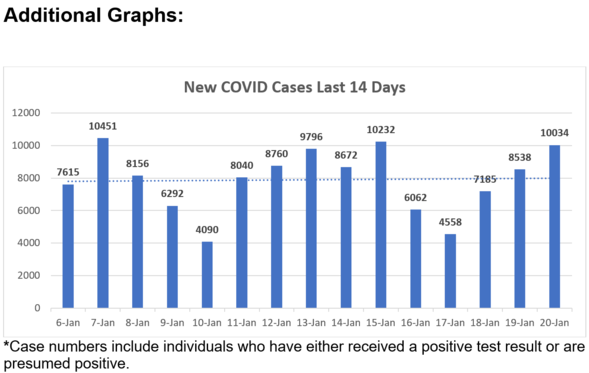

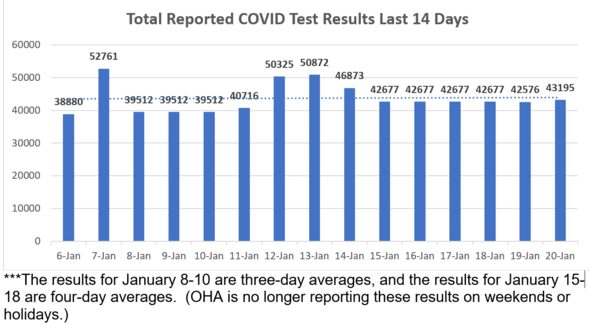

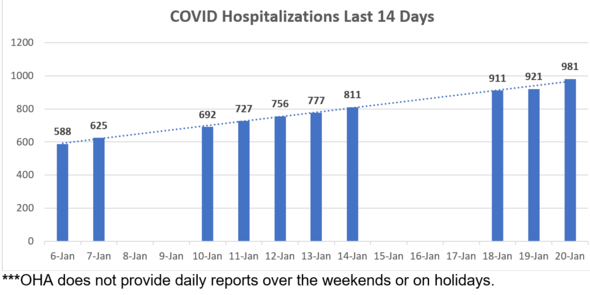
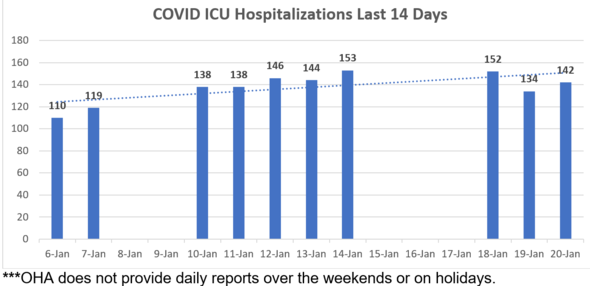
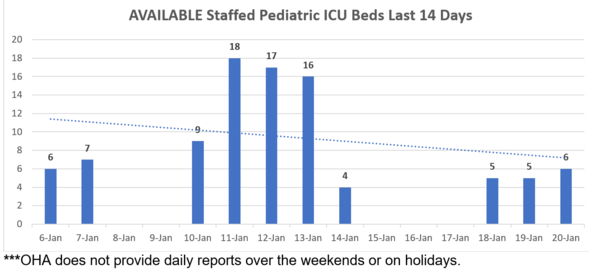
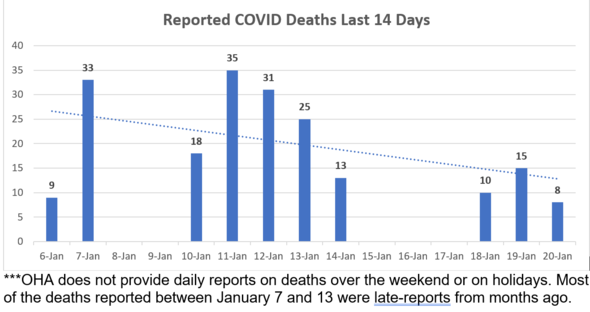
AND FINALLY,
Here again are some resources that you will find useful
If the above links are not providing you with answers to your questions or directing you to the help that you need, please consider me and my office to be a resource. We’ll do our best to assist you or steer you in the right direction.
Best,
 Senator Michael Dembrow
District 23
email: Sen.MichaelDembrow@oregonlegislature.gov
web: www.senatordembrow.com
phone: 503-281-0608
mail: 900 Court St NE, S-407, Salem, OR, 97301
|